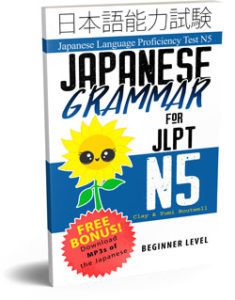Particles
Particles are the small, non-translatable words that tell the function of other words in a sentence.
This section may be the hardest for you to grasp. Memorize the examples and, just know, it will get easier with time.
が
ABOUT:
■ が usually indicates the subject of the sentence. We say usually because sometimes that task is covered by the particle は (pronounced wa) and with certain verbs, が is used after the direct object!
There are the above exceptions, but here is a simple way to look at it.
- が identifies specific or new information when the subject itself is unknown or in question.
- は, on the other hand, indicates the overall topic of the conversation.
How to Use:
■ New Information: When the subject gives the listener new information, use が.
Here is an example where we introduce a cat with が but switch to は when the cat becomes the topic:

昨日、猫がいた。
Yesterday, there was a cat (ga).
その猫は、茶色だった。
As for that cat (wa), it was brown.
In the first sentence, the cat, as new information, is introduced with a が. The cat is the subject and answers the unspoken question, "What was there yesterday?" But it is not the topic of the conversation yet. If anything, the "topic" is "yesterday." You are simply establishing the fact there was a cat.
In the second sentence, the cat is now being described and therefore, it is the topic of the conversation.
Now that the cat is labeled as the topic, you don't have to keep mentioning the cat.
For example, this might be the next sentence:
可愛かった。(the cat) was cute.
■ Question Words take が: When question words like 何 (what), だれ (who), or どこ (where) are the subject, they always take が.
だれがケーキを食べた?
Who ate the cake?
何がほしい?
What do you want?
■ Use が for Subordinate Clauses: Since a subordinate clause is apart from the topic (は), use が unless there is a contrast.
私は、ビルがいたことを知らなかった。
(As for me,) I didn't know Bill was there.
[ビルがいた (Bill was there) is the subordinate clause and therefore takes a が.]
■ Direct Object が: In some cases, が marks the object.
私は、猫が好きです。
I like cats.
[or rather: As for me, I like cats.]
In English, what we would consider the subject (I) is actually the topic. What follows relates to this topic (whatever the topic—I—likes). And what we would consider the object (cats) could be thought of as the subject of the verb.
This happens with a transitive verb or adjective. ("Transitive" just means it can take an object: I bought [transitive verb] a computer [object].)
Some common transitive verbs/adjectives that usually take が are:
- 好き (to like)
あなたが好きです。 I like you. - 嫌い (dislike)
私は、牛乳が嫌いです。 I don't like milk. - ほしい (to want)
日本の車がほしいです。 (I) want a Japanese car. [The topic is assumed to be the speaker.] - できる (to be able to)
スコットは、日本語ができます。 Scott can (speak/write/understand) Japanese.
[できます means "able to."]
MAIN POINTS:
■ Use が for new information
■ Question words take が instead of は
■ Use が with subordinate clauses
■ が is used with some transitive verbs (takes an object) even though the word it marks would be considered a direct object.
は
ABOUT:
■ As mentioned previously, は and が are very similar. There are three main uses for は as a particle: marking the topic, showing contrast, and adding emphasis.
Study Notes:
■ Oftentimes you can think of は as "as for …" or "speaking of …"
How to Use:
■ Marks the Topic: Use は to mark the topic of what the rest of the sentence is about or describing. This is normally placed at the beginning of the sentence.
私は、サムです。アメリカから来ました。
I am Sam. I came from America.
[The topic (what the following is about) is all about Sam.]
■ Adds Emphasis and Contrast: Use は to show contrast.
ペンをもっていますか?
Do you have a pen?
ペンはあります。でもノートがありません。
I have a pen, but I don't have a notebook.
The contrasting は can be thought of as "I don't know about other things, but as for …"
When は is used for contrast or emphasis, it is usually in place of が or を.
Two more examples showing contrast:
彼は赤が好きだが、私は赤は嫌いだ。
He likes red, but I don't like red (the underlined topic marker contrasts "Red" from all other colors).
テレビは見ないが、映画は見る。
I don’t watch TV, but I do watch movies (as opposed to other things like watching TV).
Consider the following comparison between が and は:
すしが好きです。
I like sushi.
(the が is simply establishing the fact the speaker likes sushi.)
すしは好きです。
(I don't know about other foods but as for) sushi, I like it.
[This person is not known to like Japanese food in general and therefore the は stresses the unexpected intention: "contrary to what you might think…" or "even though I don’t like Japanese food in general (I like sushi)"]]
MAIN POINTS:
■ は sets the overall topic, can show contrast, and can add emphasis.
■ は is mostly used for things the listener knows about. Therefore, question words (who, what, where…) cannot be used with は.
■ は takes over が when the subject is also the topic.
■ If there is a は and a が in the sentence, the は usually—but not always—goes first.
は~が
ABOUT:
■ Continuing our look at these two troublesome particles, here is perhaps the most common sentence construction in Japanese.
How to Use:
■AはBがC。
In this construction, C tells us something about B and B tells us something about A, since A is the overall topic.
私は、おなかがすきました。
I am hungry.
Lit: As for me, I | stomach | empty
[C (empty) tells us about the state of B (stomach) and B (stomach) tells us something about A (It is my stomach)]
■ When the listener knows the topic (A), the speaker can drop it since B and C are the core information.
おなかがすきました。 (I'm) hungry.
Another example:
MAIN POINTS:
■ は almost always comes first
■ は is usually dropped once the listener knows what the topic is.
を
ABOUT:
■ This is the direct object marker. It is usually spoken as "o" in modern Japanese although originally it was "wo." Some native speakers do sometimes voice the "w" today. But as a rule, pronounce it the same as お.
It is not, however, a substitute for お. を is only used (in modern Japanese) for the direct object marker.
How to Use:
■ Marks the Direct Object: In English, we don't have a particle that shows the direct object. A direct object is the object that a transitive verb acts upon.
A transitive verb is simply a verb that has an object. For example: I carried a book. ("Carried" is a transitive verb)
私は、本を読みました。
I read a book
[本 (book) is the direct object which was read]
Study Notes:
■ Caution: This particle is pretty straightforward. Just put it after the direct object. The main exception is with some verbs, が or に replaces を after what would be the direct object in English.
私は、あなたが好きです。
I like you.
[Here, あなた (you) is the object which 私 (I) likes. But as mentioned previously, が is used with 好き.]
私は、あなたに会いたいです。
I want to see you.
[あなた (you) is the object which the topic, 私 (I), wants to see. Normally, the object uses を, but に is used with 会う]
MAIN POINTS:
■ を is almost always pronounced "o" in modern Japanese. But to type it on the keyboard, you'll need to press "wo"
■ を is replaced with が or に when certain verbs are used.
に
ABOUT:
■ This particle is used for several distinct purposes. As a simplification, you can say に is a time,
location and direction marker. It also shows what the indirect object is (who or what the action is directed to)
How to Use:
Here are a few of the most common uses for the versatile に.
■ Time: Use に to indicate times or dates in which something takes place.
朝の5時に起きます。
I wake up at 5 in the morning.
[morning | 's | 5 o'clock | at | get up]
日本の学校は、四月に始まります。
Japanese schools begin in April.
[Japanese | school | April | in | start]
■ Location: Use に to indicate location of existence. In; at; on
ここに本があります。
There is a book (at) here.
[here | at | book | exists]
紙に絵を描きました。
(She) wrote on a piece of paper.
[paper | on | draw]
■ Direction or Movement Toward: Use に to show movement toward something. To; toward
東京に行きたいです。
I want to go to Tokyo.
[Tokyo | toward | like to go]
右にまがってください。
Please turn (to the) right.
[right | to | turn | please]
■ Indirect Object Marker: Use に after the object receiving the action. Think of it as "to" or "for."
私は、お父さんにケーキを買いました。
I bought a cake for my father.
[Lit: as for me, I | father | for | cake | bought]
先生は、生徒に日本語を教えました。
The teacher taught Japanese (to) the student.
[as for the teacher| student | to | Japanese language | taught]
で
ABOUT:
■ Like に, で has many uses and is equally important. We will look at で to indicate location and the use of something.
How to Use:
■ Indicates location: Use に for location of existence [ここにいる (I) am here.] but for other locations, で is used. "In," "at," "on"
日本で、勉強しました。
I studied in Japan.
[Japan | in | studied]
本屋で、日本語の本を買いました。
At the bookstore, I bought a Japanese book.
[bookstore | at | Japanese language | 's | book | bought]
■ Indicates the use of something: Use で when using something to do something. "By," "using," "in," "from," "for"
車で、行きましょう。
Let's go by car.
[car | by | let's go]
へ
ABOUT:
■ へ indicates direction or movement toward a goal. Very often に can be used whenever へ is used.
How to Use:
■ Use へ after the location or goal the action is moving toward. To; towards
Examples:
Note: in the following examples, に could also be used.
日本へ行きたいです。
I want to go to Japan.
[Japan | to | want to go]
友達へ手紙を書きました。
I wrote a letter to a friend.
[friend | to | letter | wrote]
と
ABOUT:
■ と is a particle that shows relationships. We will look at four different usages for this important particle. And; shows relationship; quotation marker; conditional: if then…
How to Use:
■ And: Using と for "and" indicates you have a full list of items. This shouldn't be used for open ended lists. Place it after each item in the list. The と after the last item is usually omitted but can be said.
私は、りんごとみかんを買いました。
I bought apples and oranges.
[as for me, I | apple | and | orange | bought]
フランス語と英語が話せます。
I can speak French and English.
[French language | and | English | can speak]
MAIN POINTS:
- Placed after each item
- Usually omitted after the final item in the list
- Used only with nouns and noun phrases (lists of things) and can't be used to combine sentences
- Must be an exhaustive list (not open ended)
How to Use:
■ Shows a relationship: When someone does something with someone else or when something is paired with something else, use と. With; as; from
私は、ジムと映画を見ました。
I saw a movie with Jim.
[Lit. as for me, I | Jim | with | movie | saw]
と is common with verbs that require two people or things to interact with each other. Verbs like 結婚する (to marry); 話す (to speak); 似る (to resemble); 喧嘩する (to argue)
■ Conditional: Use と to show if this than that. If; when; upon doing so
洗濯をすると、雨がふります。
When (I) do laundry, it rains.
[laundry | doing | upon | rain | falls]
説明書を読むと、すぐ分かります。
If (you) read the instructions, (you) will quickly understand.
[instruction manual | read | if | soon | understand]
■ Quotation or sound marker: Use と to end quotes or set off sounds or ideas.
「おはよう」と、先生が言いました。
"Good morning," the teacher said.
[good morning | (quotation marker) | teacher | said]
- It can also be used to close indirect quotations, internal thoughts, or sound effects.
And it makes sound words into adverbs.
子供は、ぱたぱたと走りました。
The child pitter-pattered as she ran.
[as for the child | pitter-patter (of footsteps) | ran]
から
ABOUT:
■ から can show a starting point (from; since), indicate what happens after some point (having done that …), or express a reason (because of that).
How to Use:
■ A starting point: Used with time and locations. From; since
6時から7時まで。
From six to seven o'clock.
[six hour | from | seven hour | until]
私は、アメリカから来ました。
I came from America.
[as for me, I | America | from | came]
ここから駅までは近いです。
From here to the station is near.
[here | from | (train) station | until | near]
■ What happens next: Since the starting point shows a state in the past, it is followed by how it changed.
信号は、赤から青に変わりました。
The traffic light changed from red to green.
[as for the traffic signal | from red | to blue | changed]
(Note, in Japan traffic lights turn "blue" rather than "green.")
■ Giving a Reason: から comes after the reason or cause and, if needed, is followed by the effect of that cause. Because; therefore; because of that
愛しているから。
Because (I) love you …
[love | because]
Because I have a test tomorrow, I'm studying.
[tomorrow | test | have | because of that | studying]
まで
ABOUT:
■ まで shows an ending point. Until; as far as; up to
How to Use:
■ An ending point: Used with time and locations. Until; by; up to
Examples:
6時から7時まで。
From six up to seven o'clock.
[six hour | from | seven | until]
家まで10分かかります。
It takes ten minutes to get to the house.
[house | until | ten minutes | takes]
私の車は、5人まで乗れます。
My car can hold up to five people.
[my | car | five people | up to | can ride]
や
ABOUT:
■ や is used to list two or more nouns or noun phrases.
Study Notes:
■ It is not an exhaustive list. And; such things as … and …
Examples:
店で、牛乳やパンを買いました。
At the store, I bought milk and bread (among other things).
[Lit. at store | milk | and | bread | bought]
好きな動物は、猫や犬やイルカです。
Animals (I) like include cats, dogs, and dolphins.
[Lit. liked | animals | cat | and | dog | dolphin]
も
ABOUT:
■ も means "too" or "also" but it has other slightly different usages: both A and B; even … (used for emphasis)
How to Use:
■ Too; also; either: Use も after the word it modifies.
田中さんも行きます。
Tanaka will also go.
[Tanaka | also | go]
■ Both A and B: Use も after both included words.
私もあなたも行きます。
You and I will both go
[I | also | you | also | go]
■ Even …: Use も after the word you wish to emphasize.
子供は、一つも人参を食べませんでした。
The child didn't eat even one carrot.
[as for child | one | even | carrot | didn't eat]
It is often used to show surprise.
こんなに大きな船もあるんですか?
Such a large boat even exists?!
[such a | large | boat | even | exists | (question marker)]
Other Forms:
■ Some common words with も:
- 私も me too
- あなたも you also
- 誰も no one;
- 何も nothing
か
ABOUT:
■ Most likely, one of the first things you learned about Japanese grammar was か is an end-sentence question marker. It is also used to show alternatives and suggest uncertainty.
How to Use:
■ Question Marker: Used to indicate a question.
今、何時ですか。
What time is it now?
[now | what time | is it?]
■ Suggests Uncertainty: か is added to question words to show uncertainty. some~ : いつか someday; どこか somewhere; 何か something
いつか、日本のどこかに行きたいです。
One day, I'd like to go somewhere in Japan.
[someday | Japan | to somewhere | like to go]
Other Forms:
■ One common expression is かどうか (whether or not…). This is often used without the どうか.
宿題があるかどうか知りません。
I don't know whether or not I have homework.
[homework | exists | (whether or not) | don't know]
Is the same thing as:
宿題があるか知りません。
I don't know whether or not I have homework.
[homework | exists | (uncertainty) | don't know]
の
ABOUT:
■ の is most often used to indicate the possessive. It also limits information, used to nominalize (make noun phrases from verbs and adjectives), and can act as an indefinite pronoun (click here for that full lesson).
HOW TO USE:
■ Possessive: Shows a relationship between two nouns or noun phrases. The apostrophe S.
これは、マイクの本です。
This is Mike's book.
[as for this | Mike | 's | book]
The connection can be extended and nested:
これは、マイクの友達の本です。
This is Mike's friend's book.
[as for this | Mike | 's | friend | 's | book]
■ Limiter: While you can sometimes still see this as a "possessive" what the の really does is "limits" information
テーブルの下
under the table
[Not just any "under" location but under the "table" - it limits the meaning of "under" to just under the table]
日本語のソフト
Japanese software
[Not just any software but "Japanese" software -- it limits the meaning of "software" to just "Japanese software"]
■ Descriptive Names: の is also used in descriptive names and titles:
くまのプーさん
Winnie the Pooh
[bear | (a specific kind of which) | Pooh
■ As a pronoun/nominalizer: This means it can turn verbs and adjectives into noun phrases.
Think of it as "one" as in:
This is a big one.
昨日、買ったのを見せて。
Show me the one you bought yesterday.
[yesterday | bought | one | (direct object marker) | please show]
You can use this の pronoun/nominalizer to point out something specific:
赤いのがほしい。
I want the red one.
[red | one | want]






Thank you, this really helps me move past my roadblock
ありがとうございます。
Thanks! I’m glad to hear it. Particles become more natural as you learn common sentence patterns. Memorizing example sentences helps a lot.